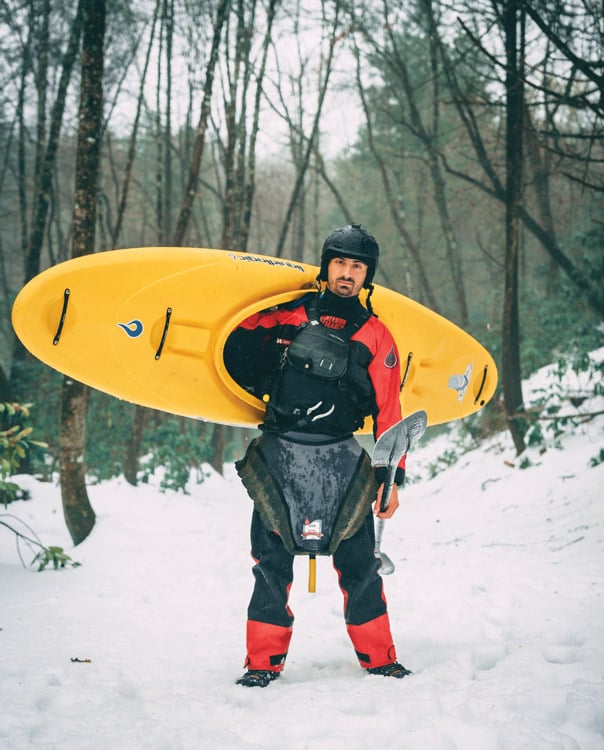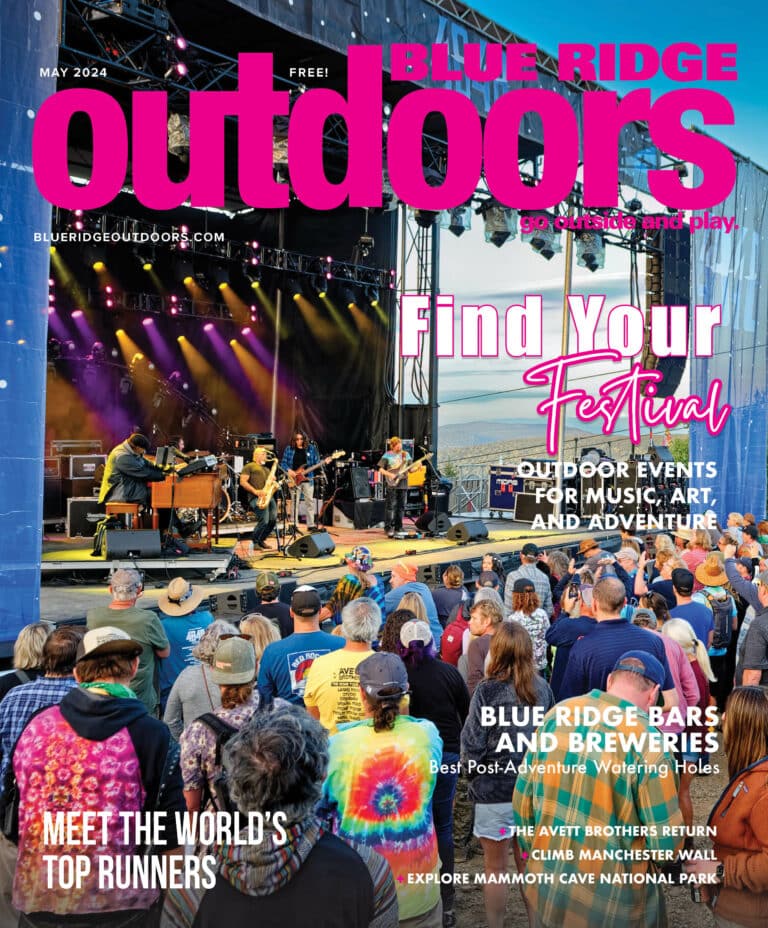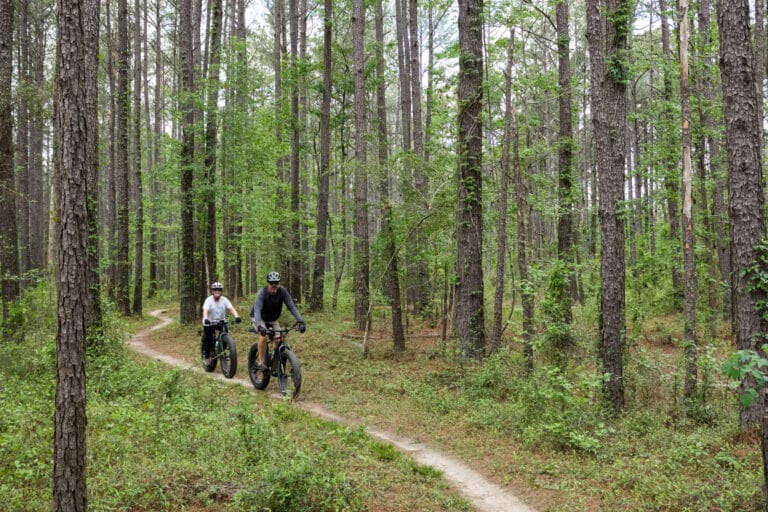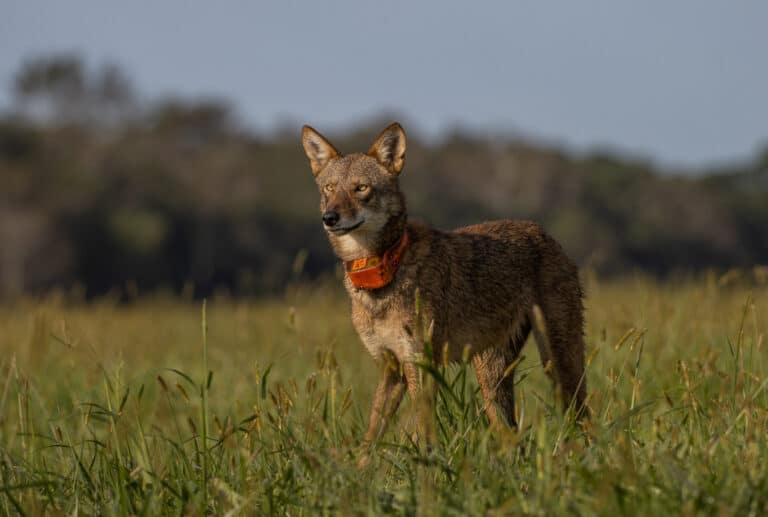Michael John Ferraro bags a first descent of Bearwallow Falls and becomes the fifth paddler to plunge down Looking Glass Falls.
If you dig WHITEWATER, you best remember the name Michael John Ferraro. 2019 is shaping up to be a big year for this 22-year-old North Carolina boater. He’s making a name for himself as a bold explorer, paddling where few others have dared to go. In January Ferraro bagged the first ever descent of 50-foot Lower Bearwallow Falls and just a few days thereafter became only the fifth kayaker in history to launch off Looking Glass Falls in the Pisgah Ranger District. Ferraro’s list of monster drops would be even more impressive if he could talk about them all, but as a part-time carpenter and full-time dirtbag, he’d rather avoid federal fines.
On the competitive side of the sport, Ferraro is equally ambitious. He took sixth in this year’s Green Race. With a new sponsor in Liquidlogic, and some fancy hot-out-the-oven boats, this feisty upstart has his eyes on the podium in 2019.
We visited Ferraro at his new house in Pisgah Forest to talk about first descents, running waterfalls, the Green Race, and why it pays to be a carpenter.
Tell us about going off Looking Glass Falls?
MJF: I’ve been looking at this thing for so long, but I hadn’t found the right water level. If it gets too high, there are these recirculating eddies on the sides that you can get caught in and at lower water it lands in a really shallow pool. It was the perfect level, so I decided to fire it up.
Describe the decision-making process.
MJF: Really the scary part of making a decision to run something like this is the decision itself, committing to putting your gear on. Once I see the line and commit to doing it, I am confident I can. Looking Glass Falls is once of the most difficult runs I’ve ever kayaked. Sure, I’ve kayaked waterfalls that are taller, but never with the depth of the pool at the bottom as a factor. I avoided hitting the bottom when I went off the falls by maintaining an angle of 45 to 60 degrees. When I was at the lip of the falls, this unexpected curler crashed onto my bow, but I was still able to maintain that angle that I wanted and land and pop up at the bottom and give a big yell.
You’ve descended another iconic Blue Ridge waterfall, which cannot be named for legal reasons. Can you at least describe that descent for us?
MJF: There were more logistics that went into this other drop. My buddy and I had to wake up super early. We knew there would be consequences if we were caught. It’s 3:45 a.m., and we have to make a large portage in the dark; there’s no trail. We lower our boats down a ravine into the eddy above the waterfall. As the sun is coming up, we peel out. I had a good line, a little bit of a harder hit than I wanted. At this point three people have run that waterfall.
How did you get the first descent of Lower Bearwallow Falls?
MJF: The Toxaway is one of the most extreme rivers in North Carolina to paddle. It’s on the fringe of what’s navigable. We had to go down that gorge and then hike back up the Bearwallow, which flows into the Toxaway. We get done with all the hard stuff on the Toxaway to then go for this first descent. It was a mission. We had to rope our boats to the top of it. It’s about 40 to 50 feet tall. At low water, it doesn’t clear a shelf, and there are some trees, too. We came in with enough speed to gap over all of that. We had two clear runs on it with my buddy Jeremy Nash. He’s only 17. He shreds though; he really gets after it.
How are you finding things that haven’t been run?
MJF: We’re just working hard to read books and search around on the internet. YouTube is a good resource because there’s a lot of people who hike to these waterfalls and this gives us a good idea of what the base flow looks like. We look on Rain Pursuit, Google Earth. There’s another platform, CalTopo, which is essentially maps layered on top of each other from years and years. We also hike a lot with boats on our shoulders, up to 10 miles a day.
Do you currently have your eyes on another first descent?
MJF: Oh yeah. There’s just so much that we’re looking at, like really small creeks that people would never even think you could kayak. In western North Carolina, there are still plenty of first descents to be had.
What’s the biggest drop you’ve made?
MJF: Metlako Falls. It’s out in the Columbia River Gorge. It was 100 feet.
How did you like Mexico?
MJF: Mexico was some of the best whitewater I’ve paddled and some of the best people I’ve met.
Where’s your dream destination?
MJF: Iceland. Epic gorges and beautiful waterfalls. There’s some first descents that we’ve been looking at over there.
What are you looking forward to most about working with Liquidlogic?
MJF: There’s going to be a new boat this spring. I’m really excited for that. Getting to have input on a boat really is a game-changer for me. Plus, I’m going to paddle with Pat Keller this summer on some rivers out West that have only been done once or twice.
You took sixth this year at the Green Race? Were you pleased with the result?
MJF: I’ve always told myself just worry about beating yourself. I kicked my own butt this year. I beat myself by seven seconds. That’s a lot. The difference between me and second place was 1.6 seconds.
How do you get ready for the Green Race?
MJF: This past year, all I did was go out and paddle. And my girlfriend Heather and I go and ride mountain bikes a lot. If I can get in the gym a little bit more it’ll also benefit me.
Is it your goal to win that race?
MJF: It is. Liquidlogic is experimenting with different types of plastic. The boat made out of this one type of plastic holds the record. I’m thinking if I can get my hands on one of those boats I can make things happen and at least get on the podium.
Any other plans for 2019?
MJF: I’m going to be doing some work as a carpenter. What’s nice about that is I can go kayaking when it rains.









